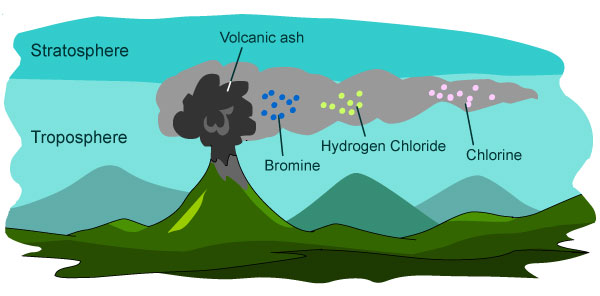- Ozone Depletion
How do volcanoes affect stratospheric ozone?
When volcanoes erupt, they produce massive clouds of ashes into the troposphere, and then they drift upward into the stratosphere (the upper atmosphere layer where ozone gas protects humans from UV radiation). These ashes contain a high concentration of bromine and chlorine. Ashes can stay in the stratosphere for about two to five years, and within this period, there are chemical reactions that destroy the stratospheric ozone molecules.
 In these volcanic ashes are some chemicals including bromine and chlorine belonging to a group of highly reactive elements called halogens, that need electrons to become stable. They get these electrons from the Ozone gas.
In these volcanic ashes are some chemicals including bromine and chlorine belonging to a group of highly reactive elements called halogens, that need electrons to become stable. They get these electrons from the Ozone gas.
Gases that destroy ozone, such as hydrogen chloride can also be found in volcanic ashes, but they dissolve readily in water. In many cases, rain can wash down these chemicals before they get high up into the stratosphere, but some do escape into it.
Human activities like pollution and emissions already send lots of halogen gases into the stratosphere — but, scientists have noted that halogens from volcanoes contain twice and thrice as many halogens that human activities even produce. This means the potential of depleting the ozone layer is higher with volcanic smoke.
Remember that the stratosphere is high up and that means when volcanic ash gets there, the impact can be over a very large area, even to the size of the entire North American region.
It is believed that the eruption of Mount Pinatubo (Philippines) in 1991 sent thick plumes 34km up into the stratosphere, where it had a significant impact on the ozone levels at the time. Other large eruptions include Tambora, Krakatau, and Agung, all of which had impacts on ozone levels.
All in all, it is known that volcanoes contribute about 18%-20% of Chlorine entering the atmosphere, and human activities also contribute about 80%-82%.
